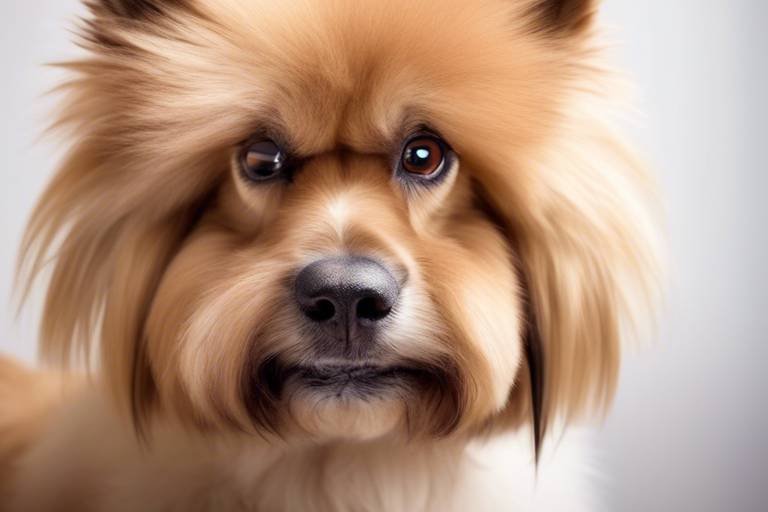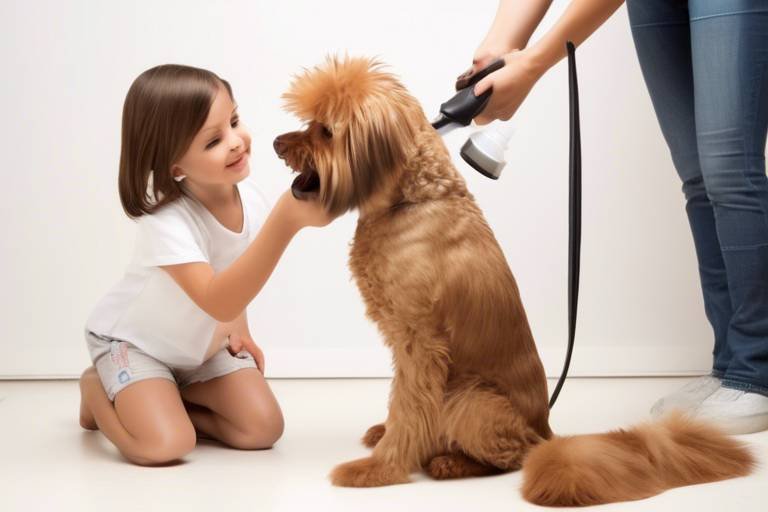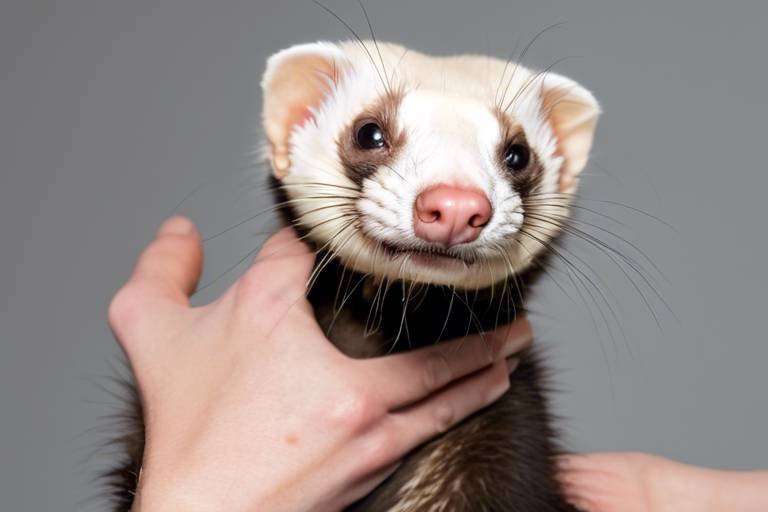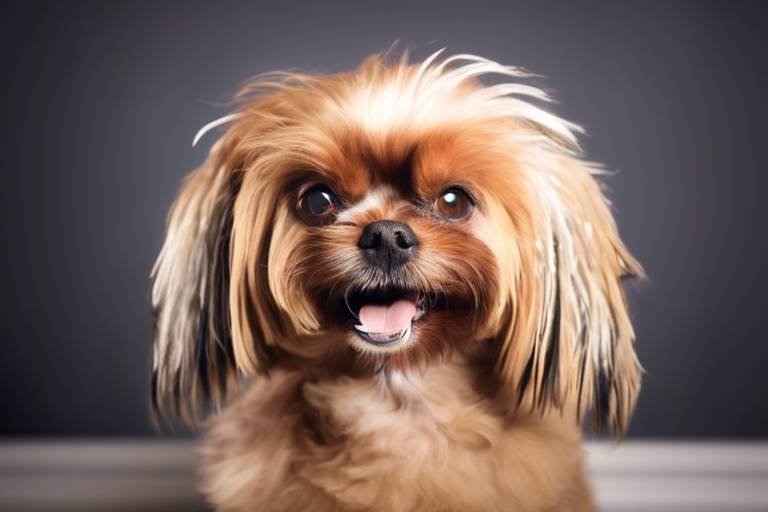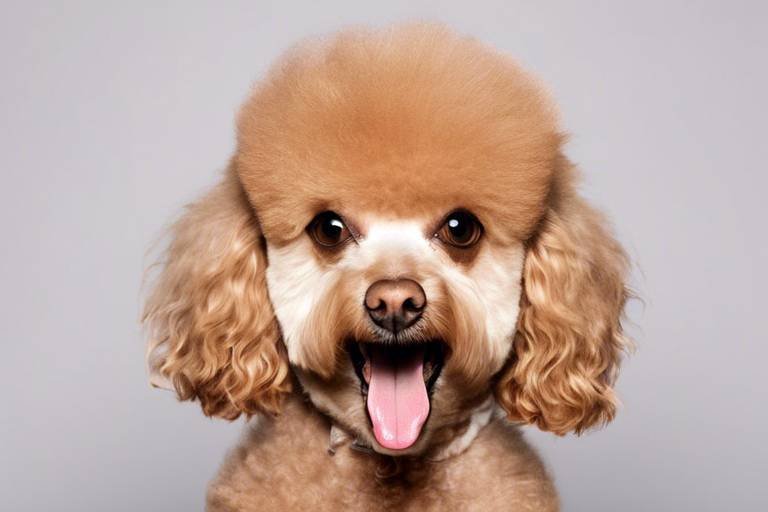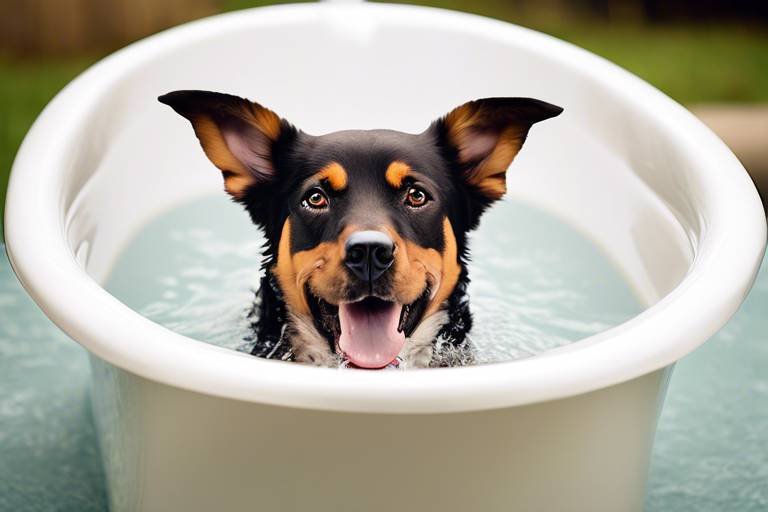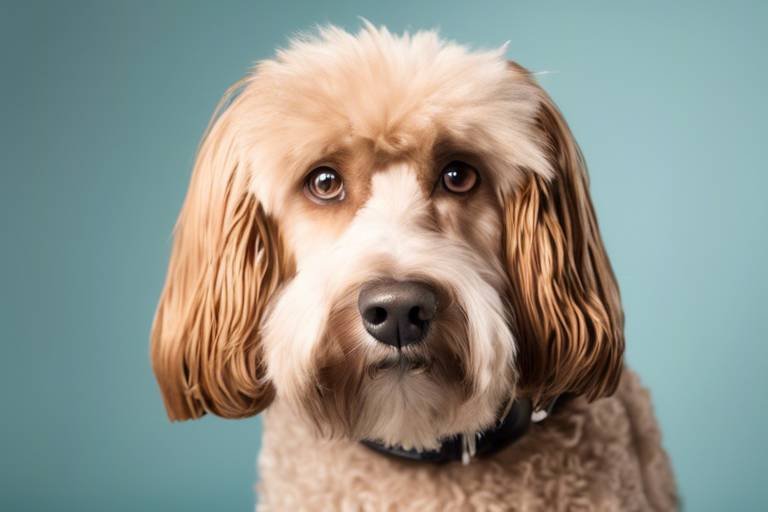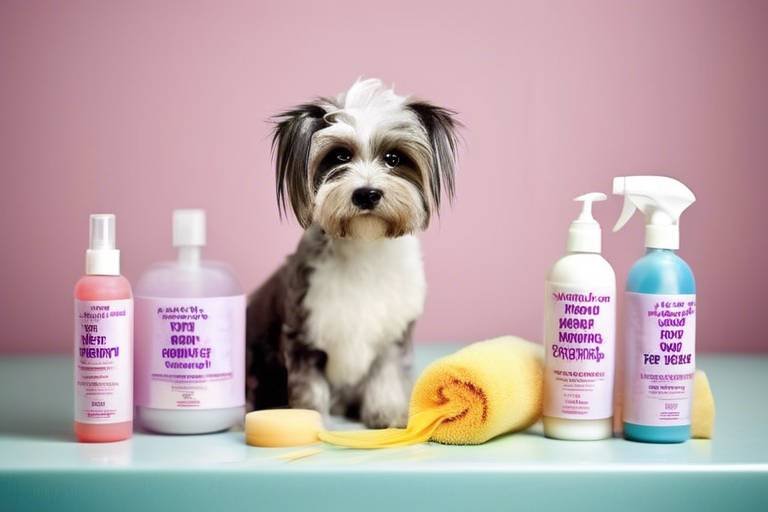Tips for Bathing and Grooming Pets with Long Hair
This article provides essential tips for effectively bathing and grooming pets with long hair, ensuring their coats remain healthy, tangle-free, and looking their best. If you’ve ever tried to manage a long-haired pet, you know it can be quite the adventure! From the majestic beauty of their flowing locks to the challenges of tangles and mats, grooming these furry friends is no small feat. But don’t worry! With the right techniques and tools, you can transform grooming time into a bonding experience that both you and your pet will enjoy.
Selecting a suitable shampoo is crucial for maintaining your pet's long hair. Look for products specifically designed for their coat type to avoid irritation and promote shine. Just like humans, pets have different skin types and coat needs. For instance, if your furry friend has sensitive skin, a gentle, hypoallergenic shampoo is a must. On the other hand, if they have a thick, luxurious coat, a moisturizing shampoo can help maintain that shine and softness. Always remember to read the labels and choose wisely!
Proper brushing techniques can prevent matting and tangles in long hair. Regular brushing not only keeps the coat smooth but also helps distribute natural oils for healthy fur. Think of brushing as a daily ritual that benefits both you and your pet. It’s a chance to bond, check for any skin issues, and keep that gorgeous coat looking fabulous. The secret? Start from the roots and work your way to the tips, using gentle strokes to avoid pulling on the hair.
Establishing a daily brushing routine can significantly reduce tangles and mats. This ensures your pet's coat remains manageable and free from debris, making bath time easier. Just imagine how much easier it is to maintain a garden with daily care versus letting it grow wild! For long-haired pets, a few minutes each day can save you hours of detangling later. Plus, your pet will love the attention!
Using the right tools, such as slicker brushes or combs, can enhance the brushing experience. Each tool serves a purpose, helping to detangle and smooth the coat effectively. For example, a slicker brush is fantastic for removing tangles, while a wide-toothed comb works wonders on wet fur. Here’s a quick overview of some essential grooming tools:
| Tool | Purpose |
|---|---|
| Slicker Brush | Detangles and removes loose fur |
| Wide-Toothed Comb | Untangles wet fur without pulling |
| Pin Brush | Distributes natural oils and smooths the coat |
Special attention should be given to sensitive areas like the belly and behind the ears. Gently brushing these spots can prevent discomfort and promote a positive grooming experience. Use a soft touch and take your time, as these areas can be particularly sensitive for many pets. If your pet seems uncomfortable, don’t hesitate to give them a break or offer treats to make the experience more enjoyable.
Understanding how often to bathe your long-haired pet is vital. Overbathing can strip natural oils, while underbathing can lead to dirt buildup and odors. Typically, a bath every 4 to 6 weeks is recommended for most long-haired breeds. However, factors like activity level and environment can influence this frequency. For example, if your pet loves to roll in the mud or swim, you might need to adjust the schedule accordingly!
Proper drying techniques are essential after bathing to prevent matting and ensure your pet's coat stays fluffy. Choose methods that suit your pet's comfort level and coat type. After a bath, it’s tempting to just let them shake it off and run around, but this can lead to tangles. Instead, consider using towels or blow dryers, depending on what your pet prefers.
Deciding between towels and blow dryers depends on your pet's tolerance. Towels are gentler, while blow dryers can speed up the drying process if used correctly. If you opt for a blow dryer, make sure to use a low heat setting and keep it at a distance to avoid discomfort. Always observe your pet’s reactions; if they seem stressed, it might be best to stick with towels.
After drying, a quick grooming session can help remove any remaining tangles and fluff the coat. This final touch ensures your pet looks and feels their best. Think of it as the cherry on top of a sundae; it completes the look! Plus, it’s a great way to check for any skin issues that might need attention.
Mats and tangles are common in long-haired pets. Learning how to effectively deal with them can save time and make grooming sessions more enjoyable for both you and your pet. If mats are left unattended, they can become painful for your pet, so it’s crucial to address them promptly.
Using specialized detangling sprays can help ease the process of removing mats. These products can make brushing easier and less painful for your furry friend. Just spray a little on the tangled areas and use a comb or brush to gently work through the knots. It’s like using conditioner on your hair; it makes everything smoother!
If mats become too severe, knowing when to seek professional grooming help is important. Professionals have the tools and experience to safely address tough tangles without causing harm. If you find yourself feeling overwhelmed, don’t hesitate to reach out to a groomer. They can provide valuable tips and tricks for maintaining your pet’s coat between visits.
- How often should I brush my long-haired pet? Ideally, daily brushing is recommended to prevent tangles and mats.
- Can I use human shampoo on my pet? No, it’s best to use pet-specific shampoos to avoid skin irritation.
- What should I do if my pet hates baths? Try making bath time more enjoyable with treats and positive reinforcement.
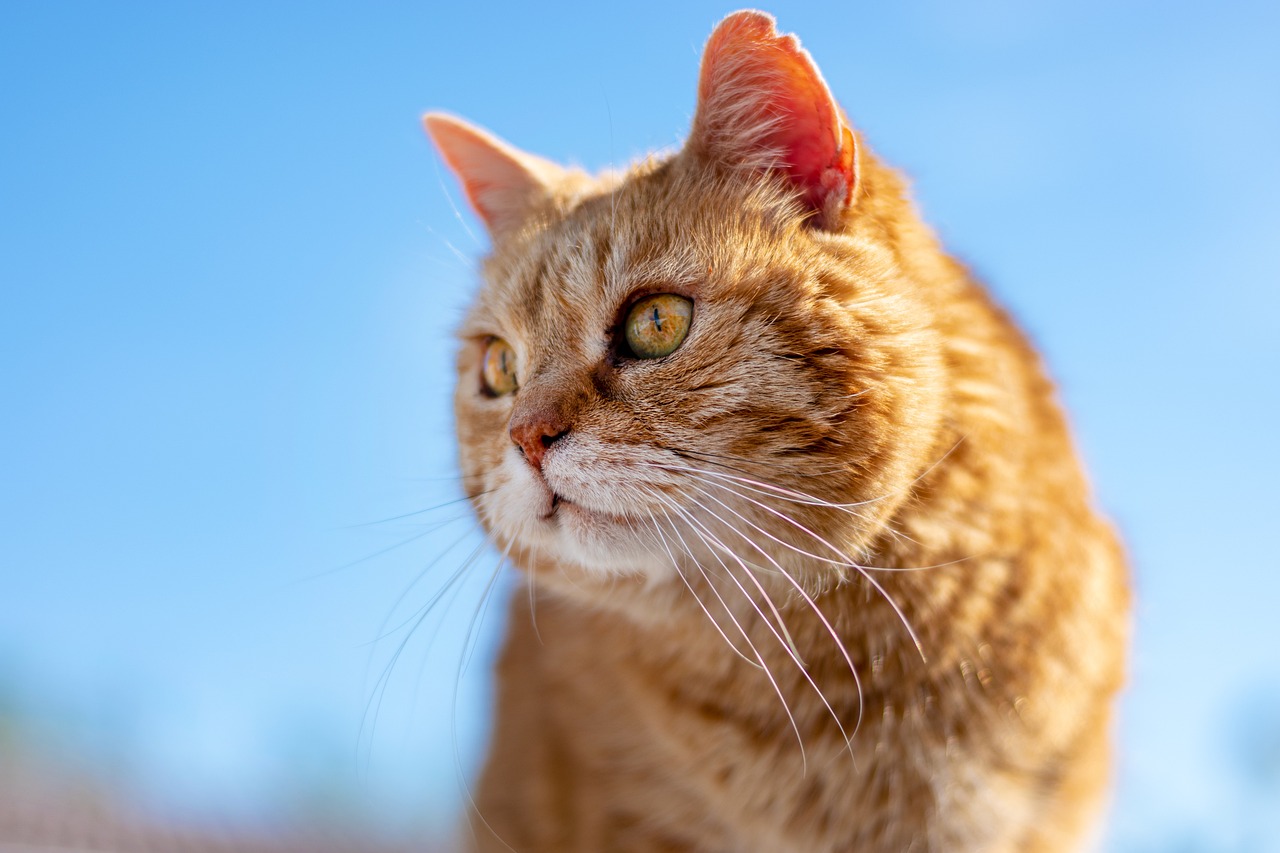
Choosing the Right Shampoo
When it comes to bathing your long-haired pet, selecting the right shampoo is absolutely essential. Just like humans, pets have different skin types and coat needs, and using the wrong product can lead to irritation, dryness, or even allergic reactions. So, how do you choose the best shampoo for your furry friend? Here are some key considerations to keep in mind:
First, always look for shampoos that are specifically formulated for your pet's coat type. For instance, if your pet has a silky coat, a moisturizing shampoo can help enhance its shine and softness. Conversely, if your pet has a curly or wiry coat, look for a shampoo that offers extra conditioning to help keep the curls defined and frizz-free. Additionally, consider your pet's skin sensitivity; hypoallergenic shampoos are a great option for pets with sensitive skin.
Another important factor is the presence of natural ingredients. Many pet owners are opting for organic and natural shampoos that avoid harsh chemicals. Ingredients like oatmeal, aloe vera, and coconut oil can provide soothing benefits and nourishment to both the skin and coat. Always check the ingredient list to ensure it’s free from sulfates, parabens, and artificial fragrances, which can be harsh on your pet's skin.
It’s also wise to consider the pH balance of the shampoo. Pets have a different skin pH than humans, so using a product designed specifically for pets will help maintain their skin health. A good rule of thumb is to choose shampoos that are labeled as "pH balanced for pets." This ensures that the product will clean without stripping away the natural oils that keep their coat healthy.
Lastly, don’t forget about your pet's specific needs. For example, if your pet suffers from skin conditions like eczema or allergies, you might want to consult with your veterinarian for recommendations on medicated shampoos. These specialized products can help manage skin issues effectively while still keeping your pet's coat clean and healthy.
In summary, choosing the right shampoo for your long-haired pet involves understanding their unique needs, being mindful of ingredients, and considering their skin type. With the right product, bath time can become a pleasant experience for both you and your pet, leaving them looking fabulous and feeling fresh!
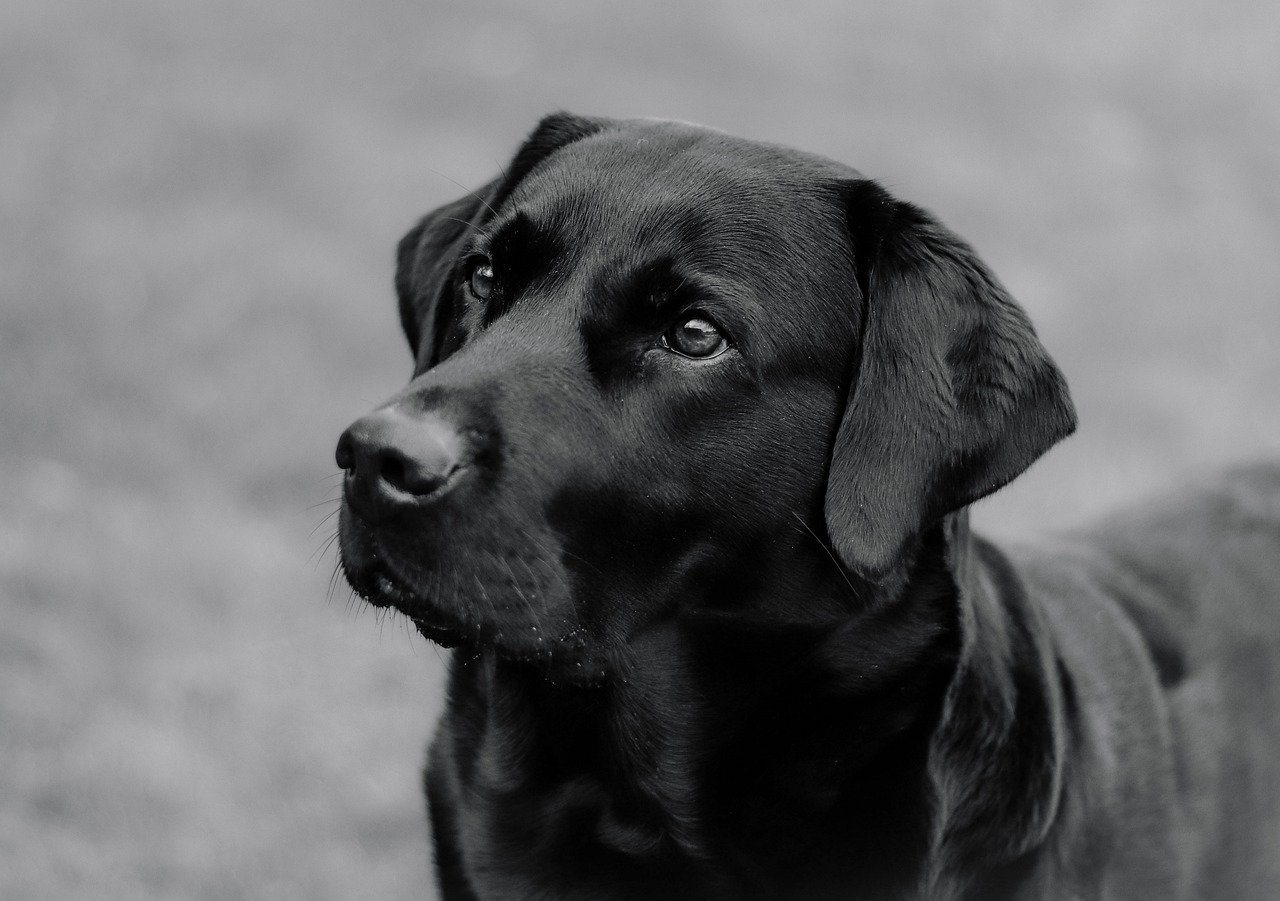
Brushing Techniques
This article provides essential tips for effectively bathing and grooming pets with long hair, ensuring their coats remain healthy, tangle-free, and looking their best.
Selecting a suitable shampoo is crucial for maintaining your pet's long hair. Look for products specifically designed for their coat type to avoid irritation and promote shine.
When it comes to maintaining long-haired pets, play a pivotal role. It's not just about keeping their fur looking fabulous; it's about ensuring their coat remains healthy and free from tangles. Imagine your pet's coat as a beautiful tapestry; if you don’t care for it properly, it can quickly become a jumbled mess of threads. Regular brushing can prevent this chaos and keep your furry friend looking their best.
To achieve optimal results, start by investing in the right tools. A slicker brush is excellent for removing loose hair and detangling, while a wide-toothed comb can help with larger knots. Using the right tool is like having the correct key to a lock; it makes the job much easier. Remember, the goal is to make this process enjoyable for your pet. Try to make brushing a part of your daily routine, as it will not only help keep their coat manageable but also foster a bond between you and your pet.
Establishing a daily brushing routine can significantly reduce tangles and mats. Think of it as a daily ritual that both you and your pet can look forward to. Consistency is key here! By dedicating just a few minutes each day to brush your pet, you can ensure their coat remains manageable and free from debris. Plus, it makes bath time a breeze. No one wants to wrestle with a clump of fur in the tub!
Using the right tools can enhance the brushing experience immensely. Here's a quick overview of some effective tools:
| Tool | Purpose |
|---|---|
| Slicker Brush | Removes loose hair and detangles fur |
| Wide-Toothed Comb | Great for larger knots and distributing oils |
| Pin Brush | Ideal for fluffing and smoothing the coat |
Each tool serves a specific purpose, helping to detangle and smooth the coat effectively. Remember to brush gently; your pet's comfort should always come first. If they seem uncomfortable, take a break and try again later.
Special attention should be given to sensitive areas like the belly and behind the ears. These spots can be particularly prone to tangles and mats. Gently brushing these areas can prevent discomfort and promote a positive grooming experience. Think of it like giving your pet a little massage; it can be a soothing experience for them. Use your fingers to separate the hair before brushing to minimize any pulling. This way, you can ensure that your pet not only looks good but feels good too!
Understanding how often to bathe your long-haired pet is vital. Overbathing can strip natural oils, while underbathing can lead to dirt buildup and odors. Finding that sweet spot will keep your pet fresh without compromising their coat health.
Proper drying techniques are essential after bathing to prevent matting and ensure your pet's coat stays fluffy. Choose methods that suit your pet's comfort level and coat type.
Deciding between towels and blow dryers depends on your pet's tolerance. Towels are gentler, while blow dryers can speed up the drying process if used correctly.
After drying, a quick grooming session can help remove any remaining tangles and fluff the coat. This final touch ensures your pet looks and feels their best.
Mats and tangles are common in long-haired pets. Learning how to effectively deal with them can save time and make grooming sessions more enjoyable for both you and your pet.
Using specialized detangling sprays can help ease the process of removing mats. These products can make brushing easier and less painful for your furry friend.
If mats become too severe, knowing when to seek professional grooming help is important. Professionals have the tools and experience to safely address tough tangles without causing harm.
Q: How often should I brush my long-haired pet?
A: Ideally, you should brush your long-haired pet daily to prevent tangles and mats.
Q: Can I use human shampoo on my pet?
A: No, human shampoo can irritate your pet's skin. Always choose a shampoo specifically formulated for pets.
Q: What should I do if my pet has severe mats?
A: If mats are too severe, consider seeking professional grooming assistance to avoid hurting your pet.
Q: How can I make brushing more enjoyable for my pet?
A: Incorporate treats and praise during brushing sessions to create a positive experience for your pet.
Daily Brushing Routine
Establishing a for your long-haired pet is not just a chore; it’s a bonding experience that can transform grooming time into a delightful ritual for both of you. Imagine this: you and your furry friend, cozy in a sunlit room, while you gently brush away tangles and dirt. Sounds nice, right? But it’s not just about the comfort—regular brushing plays a crucial role in maintaining your pet’s coat health.
When you brush your pet daily, you’re not only preventing those pesky mats from forming but also helping to distribute their natural oils evenly throughout their coat. This action keeps their fur looking shiny and healthy. The process can be likened to giving your pet a mini spa treatment—who wouldn’t want that? Plus, it’s a fantastic way to check for any skin issues or parasites lurking beneath all that fluff.
Now, you might be wondering, “How do I make this routine effective?” Here are a few tips to ensure your daily brushing is as efficient as possible:
- Set a specific time: Choose a time of day that works best for both you and your pet. Consistency helps them get used to the routine.
- Use the right tools: As mentioned earlier, having the right brushes and combs can make all the difference. A slicker brush is great for detangling, while a wide-toothed comb can help smooth things out.
- Be gentle: Always brush with care, especially in sensitive areas. If you encounter a tangle, don’t yank it out. Instead, work it out gently with your fingers or a detangling spray.
Incorporating these practices into your daily routine can significantly reduce the time spent on grooming sessions. Think of it as a preventive measure—spending a few minutes each day can save you hours of frustration later on. And who knows? Your pet might even start to look forward to this special time together!
Lastly, remember that patience is key. Some pets may take a little longer to adjust to the daily brushing routine, especially if they are not used to it. But with time, they will learn that this is a loving gesture and not just another task on your to-do list. So grab that brush, find a comfy spot, and turn grooming into a cherished part of your day!
Q: How long should I brush my long-haired pet each day?
A: Aim for about 10-15 minutes daily. This duration is usually sufficient to keep their coat tangle-free and healthy.
Q: What if my pet doesn’t like being brushed?
A: Start slowly and make the experience positive. Reward them with treats and praise to create a positive association with brushing.
Q: Can I use human hair products on my pet?
A: It’s best to use products specifically designed for pets. Human shampoos can irritate their skin and disrupt the natural oils in their fur.
Q: How do I know if my pet needs a bath?
A: If your pet starts to smell, has visible dirt or debris in their coat, or if their fur feels greasy, it’s time for a bath.
Tools for Effective Brushing
When it comes to grooming your long-haired pet, having the right tools can make all the difference. Think of grooming as a dance; the right partner (or tools) can turn a chaotic routine into a smooth performance. There are several essential tools you should consider to ensure that your pet's coat remains tangle-free and healthy.
First up, the slicker brush is a must-have in your grooming arsenal. This brush features fine, short wires close together, making it perfect for removing mats and tangles while also distributing natural oils throughout the coat. It’s like giving your pet a mini massage while you brush! For pets with particularly thick or curly coats, a dematting comb can be incredibly beneficial. This tool is designed specifically to tackle stubborn mats without pulling too harshly on your pet’s skin.
Another handy tool is the wide-toothed comb. This is especially useful for detangling after a bath when the hair is wet and more susceptible to breakage. Using a comb with wider teeth allows you to gently work through knots without causing too much discomfort. It's like using a gentle breeze to untangle a kite string—slow and steady wins the race!
For those delicate areas, such as behind the ears or the belly, a soft bristle brush can be your best friend. This brush is gentle enough to avoid irritating sensitive skin while still helping to remove loose fur and dirt. You want your pet to feel relaxed during grooming, and a soft brush can help create a calming experience.
To keep your grooming sessions organized and efficient, consider investing in a grooming caddy. This can be a simple basket or a more elaborate organizer where you can store all your tools. Having everything at your fingertips means you won’t waste time searching for that elusive brush, making the whole process smoother. Just like a chef has their utensils ready, you should have your grooming tools within reach!
Finally, don’t forget about the importance of treats during grooming sessions. While not a grooming tool per se, having some tasty snacks on hand can help create a positive association with brushing. Rewarding your pet after a good grooming session can turn it into something they look forward to, rather than a chore. After all, who doesn’t love a little incentive?
In summary, having the right tools for brushing your long-haired pet is crucial for maintaining their coat's health and appearance. From slicker brushes to grooming caddies, each item plays a vital role in ensuring your furry friend looks fantastic while feeling comfortable. So, gather your tools, and let the grooming begin!
- How often should I brush my long-haired pet? Ideally, you should brush your long-haired pet daily to prevent tangles and mats.
- Can I use human shampoo on my pet? It's best to use pet-specific shampoos as human products can irritate their skin.
- What should I do if my pet has severe mats? If mats are too severe, it may be time to consult a professional groomer for assistance.
Brushing Sensitive Areas
When it comes to grooming your long-haired pet, is crucial for a positive experience. Pets, just like humans, have spots that are more sensitive than others. These areas can include the belly, behind the ears, and even the tail. If you rush through these spots or use too much pressure, your furry friend might feel uncomfortable, which could lead to a negative association with grooming. Imagine if someone tugged at your hair without warning; you'd likely flinch, right? The same goes for your pet.
To make the grooming process smoother, it’s essential to approach these sensitive areas with care. Start by gently lifting the fur with your fingers to assess any tangles or mats. Once you’ve identified any problem spots, use a soft brush or a comb designed for sensitive areas. Always brush in the direction of hair growth, as this not only feels better for your pet but also helps to avoid pulling on the skin. If you encounter a particularly stubborn tangle, resist the urge to yank it out. Instead, try using a detangling spray or conditioner to soften the fur, making it easier to brush through.
Don't forget to reward your pet with praise or treats during and after grooming, especially when brushing those sensitive areas. This positive reinforcement helps them associate grooming with a pleasant experience, making future sessions easier. Remember, patience is key! If your pet seems anxious or uncomfortable, take a break and try again later. Grooming should be a bonding experience, not a battle.
In summary, brushing sensitive areas requires a gentle touch, the right tools, and a lot of love. By taking the time to focus on these spots, you not only keep your pet looking great but also help them feel safe and secure during grooming sessions. This will make both of your lives easier in the long run!
- How often should I brush my long-haired pet? It’s best to brush them daily to prevent tangles and mats.
- What type of brush is best for sensitive areas? A soft-bristle brush or a wide-tooth comb is ideal for sensitive spots.
- Can I use human shampoo on my pet? No, always choose a shampoo specifically formulated for pets to avoid skin irritation.
- What should I do if my pet resists brushing? Take it slow, use treats, and create a calm environment to help them relax.
Frequency of Baths
Understanding how often to bathe your long-haired pet is vital for maintaining their coat health. Overbathing can strip away the natural oils that keep their fur shiny and healthy, while underbathing can lead to a buildup of dirt, odors, and even skin issues. So, what's the sweet spot? Generally, it's recommended to bathe long-haired pets every 4 to 6 weeks. However, this can vary based on several factors including the breed, activity level, and environment of your furry friend.
For instance, if your pet loves to roll around in the mud or has a tendency to get into mischief outdoors, you might find yourself needing to give them a bath more frequently. On the other hand, if your pet is more of a couch potato and stays indoors, stretching the bathing schedule to every 6 to 8 weeks could work just fine. It's all about finding a balance that keeps your pet clean and comfortable.
Here are a few considerations to keep in mind when determining your pet's bathing frequency:
- Coat Type: Different breeds have different coat types that can affect how often they need a bath. For example, breeds with oily coats may require more frequent bathing compared to those with drier fur.
- Skin Conditions: If your pet has any skin issues, consult your veterinarian. They may recommend specific bathing schedules or medicated shampoos to manage those conditions.
- Seasonal Changes: During shedding seasons, you might notice more dirt and dander, which could necessitate a bath sooner than usual.
Ultimately, the key is to monitor your pet’s coat and skin condition closely. If their fur feels greasy or looks dull, it might be time for a bath. Conversely, if their coat looks vibrant and feels clean, you can probably wait a bit longer. Remember, every pet is unique, and finding the right bathing frequency for your long-haired companion is essential for their overall well-being.
Q: How can I tell if my long-haired pet needs a bath?
A: If your pet's coat feels greasy, looks dull, or has an odor, it’s likely time for a bath. Additionally, if they’ve been outdoors frequently or have rolled in something messy, a bath is a good idea.
Q: What should I do if my pet hates baths?
A: Start by making bath time a positive experience. Use treats, toys, and gentle handling to create a calm environment. You can also try using a handheld showerhead or a cup to pour water gently, which can be less intimidating.
Q: Can I use human shampoo on my pet?
A: It’s best to avoid using human shampoo as it can irritate your pet’s skin. Instead, choose a shampoo specifically formulated for pets, tailored to their coat type.
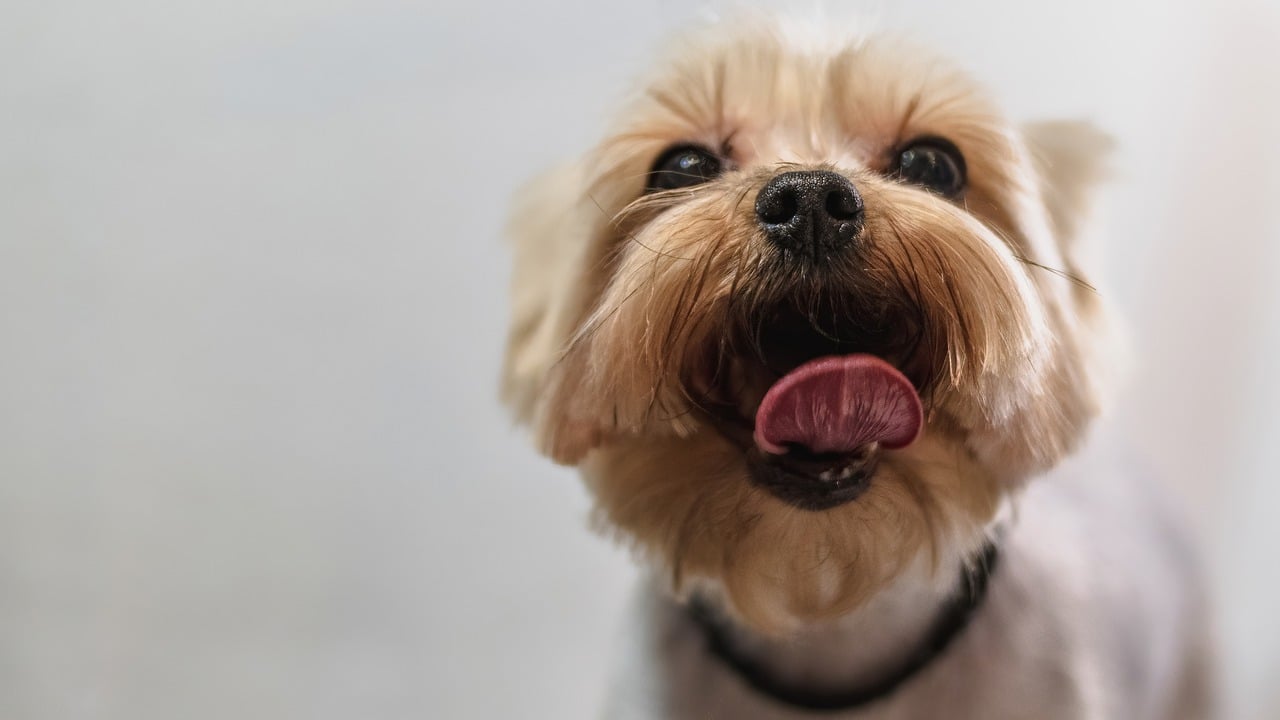
Drying Techniques
After a refreshing bath, the next step in grooming your long-haired pet is drying their coat effectively. Proper are essential not only for maintaining the fluffiness of their fur but also for preventing any potential matting that can occur if the coat remains damp for too long. Think of it like drying a sponge; if you don't wring it out properly, it can stay soggy and start to smell. The same goes for your furry friend!
When it comes to drying your pet, you have a couple of options: towels and blow dryers. Each method has its advantages, and the choice largely depends on your pet's personality and comfort level. For instance, many pets may find the sound of a blow dryer intimidating, while others might enjoy the warmth it provides. On the other hand, towels are gentle and quiet, making them a great option for more skittish animals. It’s crucial to observe your pet's reaction to each method to determine what works best for them.
Here’s a quick breakdown of the pros and cons of each drying technique:
| Drying Method | Pros | Cons |
|---|---|---|
| Towels |
|
|
| Blow Dryers |
|
|
Regardless of the method you choose, it's important to keep the dryer at a safe distance from your pet’s skin to prevent burns. If using a blow dryer, start at the lowest heat setting and gradually increase as necessary. Always keep the nozzle moving to avoid concentrating heat on one spot for too long. Remember, your pet's comfort is paramount; if they seem anxious or uncomfortable, it might be best to revert to towels.
After you've dried your pet, a quick grooming session can be beneficial. This is the perfect time to check for any lingering tangles or mats that may have formed during the bath. A gentle brush through their coat can help fluff it up, leaving your pet looking and feeling fabulous!
Q1: How often should I bathe my long-haired pet?
A1: It depends on the breed and lifestyle of your pet. Generally, bathing every 4-6 weeks is sufficient, but always consult your veterinarian for personalized advice.
Q2: Can I use human shampoo on my pet?
A2: No, human shampoos can irritate your pet's skin. Always opt for pet-specific shampoos that cater to their coat type.
Q3: What should I do if my pet hates being dried?
A3: If your pet is uncomfortable with drying, try using towels first or consider a low-noise dryer. Patience and positive reinforcement can help make the experience more enjoyable.
Using Towels vs. Blow Dryers
This article provides essential tips for effectively bathing and grooming pets with long hair, ensuring their coats remain healthy, tangle-free, and looking their best.
Selecting a suitable shampoo is crucial for maintaining your pet's long hair. Look for products specifically designed for their coat type to avoid irritation and promote shine.
Proper brushing techniques can prevent matting and tangles in long hair. Regular brushing not only keeps the coat smooth but also helps distribute natural oils for healthy fur.
Establishing a daily brushing routine can significantly reduce tangles and mats. This ensures your pet's coat remains manageable and free from debris, making bath time easier.
Using the right tools, such as slicker brushes or combs, can enhance the brushing experience. Each tool serves a purpose, helping to detangle and smooth the coat effectively.
Special attention should be given to sensitive areas like the belly and behind the ears. Gently brushing these spots can prevent discomfort and promote a positive grooming experience.
Understanding how often to bathe your long-haired pet is vital. Overbathing can strip natural oils, while underbathing can lead to dirt buildup and odors.
Proper drying techniques are essential after bathing to prevent matting and ensure your pet's coat stays fluffy. Choose methods that suit your pet's comfort level and coat type.
When it comes to drying your long-haired pet after a bath, the choice between towels and blow dryers can significantly impact their comfort and the health of their coat. Towels are often seen as the gentler option; they absorb moisture without causing the fur to become frizzy or tangled. Just imagine wrapping your pet in a warm, fluffy towel after a bath—it's like giving them a cozy hug! However, if your pet is comfortable with it, using a blow dryer can expedite the drying process. It’s essential to use a low heat setting to avoid overheating their skin.
Here’s a quick comparison to help you decide:
| Method | Pros | Cons |
|---|---|---|
| Towels |
|
|
| Blow Dryers |
|
|
Ultimately, the choice between towels and blow dryers depends on your pet's personality and tolerance. Some pets might absolutely love the feeling of a warm blow dryer, while others may find it intimidating. It’s always best to observe your pet’s reactions and choose the method that makes them feel most comfortable.
After drying, a quick grooming session can help remove any remaining tangles and fluff the coat. This final touch ensures your pet looks and feels their best.
Mats and tangles are common in long-haired pets. Learning how to effectively deal with them can save time and make grooming sessions more enjoyable for both you and your pet.
Using specialized detangling sprays can help ease the process of removing mats. These products can make brushing easier and less painful for your furry friend.
If mats become too severe, knowing when to seek professional grooming help is important. Professionals have the tools and experience to safely address tough tangles without causing harm.
Q: How often should I bathe my long-haired pet?
A: Generally, every 4-6 weeks is ideal, but it depends on their activity level and coat condition.
Q: What if my pet hates baths?
A: Gradual acclimatization and using treats can help make bath time more enjoyable for them.
Q: Are there any specific shampoos I should avoid?
A: Avoid human shampoos, as they can irritate your pet's skin. Always choose pet-specific products.
Post-Bath Grooming
This article provides essential tips for effectively bathing and grooming pets with long hair, ensuring their coats remain healthy, tangle-free, and looking their best.
Selecting a suitable shampoo is crucial for maintaining your pet's long hair. Look for products specifically designed for their coat type to avoid irritation and promote shine.
Proper brushing techniques can prevent matting and tangles in long hair. Regular brushing not only keeps the coat smooth but also helps distribute natural oils for healthy fur.
Establishing a daily brushing routine can significantly reduce tangles and mats. This ensures your pet's coat remains manageable and free from debris, making bath time easier.
Using the right tools, such as slicker brushes or combs, can enhance the brushing experience. Each tool serves a purpose, helping to detangle and smooth the coat effectively.
Special attention should be given to sensitive areas like the belly and behind the ears. Gently brushing these spots can prevent discomfort and promote a positive grooming experience.
Understanding how often to bathe your long-haired pet is vital. Overbathing can strip natural oils, while underbathing can lead to dirt buildup and odors.
Proper drying techniques are essential after bathing to prevent matting and ensure your pet's coat stays fluffy. Choose methods that suit your pet's comfort level and coat type.
Deciding between towels and blow dryers depends on your pet's tolerance. Towels are gentler, while blow dryers can speed up the drying process if used correctly.
After your pet has enjoyed a refreshing bath, it's time to focus on . This crucial step not only enhances your pet's appearance but also ensures their coat remains healthy and free from tangles. Start by gently fluffing the coat with your fingers to separate the strands. This is especially important for long-haired breeds, as it helps to aerate the fur and remove any residual moisture.
Next, grab your favorite grooming tools. A slicker brush is fantastic for detangling, while a wide-toothed comb can help smooth out any stubborn knots. As you groom, pay attention to areas that are prone to matting, such as the underbelly and behind the ears. A quick grooming session after drying can help remove any remaining tangles and fluff the coat, ensuring your pet looks and feels their best. Don't forget to reward your furry friend with some praise or a treat; this positive reinforcement makes grooming a more enjoyable experience for both of you!
Mats and tangles are common in long-haired pets. Learning how to effectively deal with them can save time and make grooming sessions more enjoyable for both you and your pet.
Using specialized detangling sprays can help ease the process of removing mats. These products can make brushing easier and less painful for your furry friend.
If mats become too severe, knowing when to seek professional grooming help is important. Professionals have the tools and experience to safely address tough tangles without causing harm.
- How often should I bathe my long-haired pet? It depends on their activity level and coat type, but generally, every 4-6 weeks is a good rule of thumb.
- What tools are best for brushing? Slicker brushes and wide-toothed combs are highly recommended for long-haired pets.
- Can I use human shampoo on my pet? It's best to avoid human shampoo as it can irritate your pet's skin. Always choose pet-specific products.
- What should I do if my pet has severe mats? If you encounter severe mats, it may be best to consult a professional groomer to avoid hurting your pet.
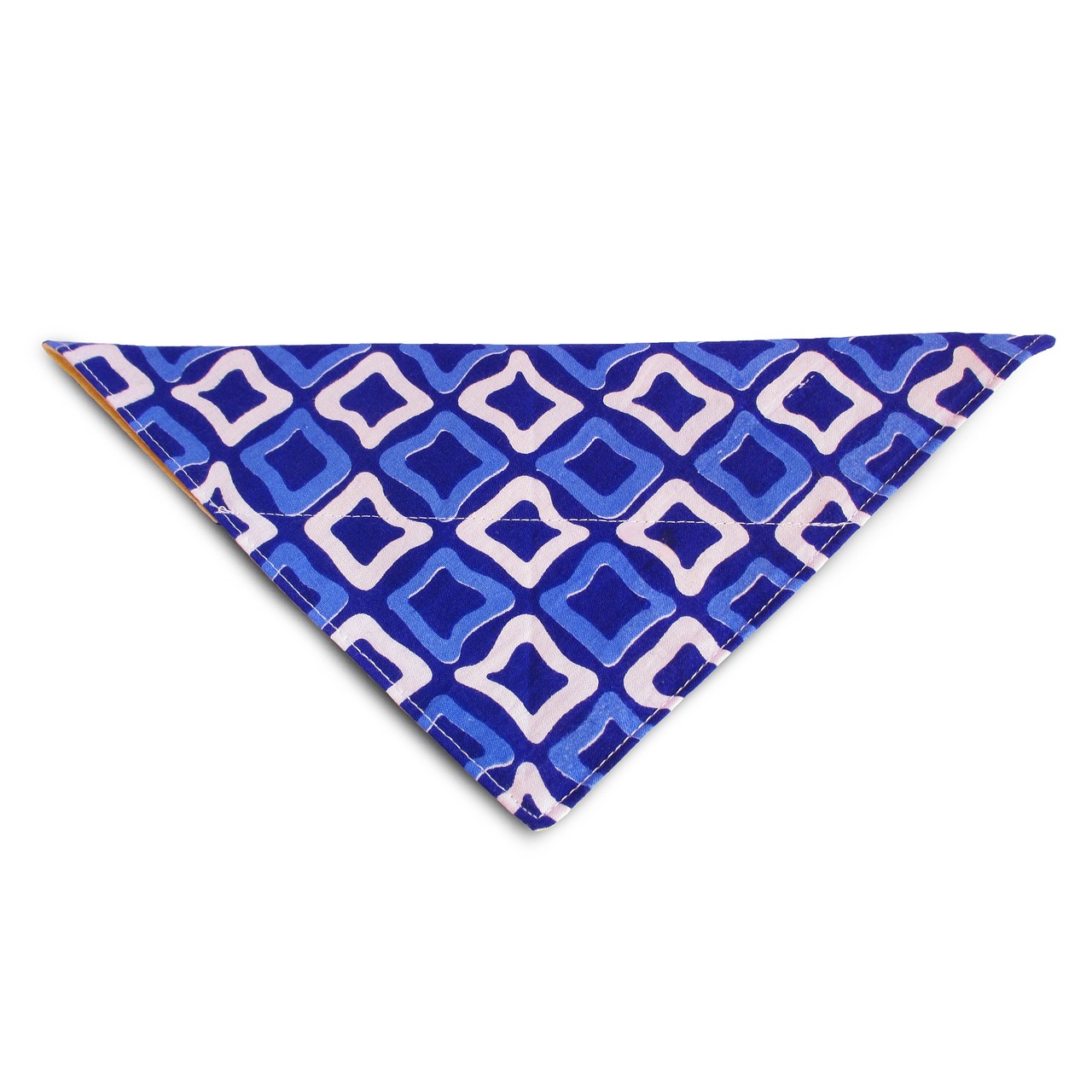
Dealing with Mats and Tangles
When it comes to our furry friends with long hair, dealing with mats and tangles can feel like a daunting task. These pesky knots can form quickly, especially if your pet enjoys outdoor adventures or simply loves to roll around on the carpet. To tackle this challenge effectively, it’s essential to approach grooming with both patience and the right techniques. Think of it as untangling a necklace that’s been in your jewelry box for too long; it requires a gentle touch and a bit of time!
First and foremost, understanding the types of mats and tangles your pet may develop is crucial. Mats can form due to a variety of reasons, including:
- Moisture: Damp fur can clump together, leading to mats.
- Shedding: Loose hair can get trapped in the longer fur, creating tangles.
- Friction: Areas where your pet lies or rubs against surfaces can cause tangling.
To effectively manage these issues, consider incorporating some specialized detangling products into your grooming routine. Detangling sprays are designed to make the brushing process smoother, reducing discomfort for your pet. When applying these products, make sure to:
- Spray directly onto the mat or tangle.
- Gently work the product into the fur with your fingers.
- Allow it to sit for a few minutes before brushing.
Additionally, it's important to have the right tools on hand. A good quality slicker brush or a wide-toothed comb can be your best friends in this battle against mats. Start by using your fingers to gently pull apart the mat before moving on to the brush. This method helps to minimize pulling on your pet's skin, making the experience less painful for them.
However, there are times when mats can become too severe, and that's when you need to consider knowing when to seek professional help. Professional groomers have specialized tools and experience that can make quick work of even the toughest tangles. If you find yourself spending too much time on a single mat or if your pet is showing signs of distress, don’t hesitate to reach out to the pros. Remember, your pet's comfort and well-being should always come first!
Q: How often should I groom my long-haired pet?
A: Ideally, you should groom your long-haired pet at least once a week. However, daily brushing is recommended to prevent mats and tangles.
Q: Can I use human shampoo on my pet?
A: No, human shampoos can irritate your pet's skin. Always choose a shampoo specifically formulated for pets.
Q: What should I do if my pet dislikes being groomed?
A: Gradually introduce grooming sessions, starting with short periods of brushing and rewarding your pet with treats. This helps create a positive association.
Detangling Products
When it comes to grooming our long-haired pets, can be a game-changer. These specially formulated sprays and creams are designed to ease the burden of mats and tangles, making the grooming process not only easier but also more enjoyable for your furry friend. Imagine trying to untangle a knot in your own hair without the right tools—frustrating, right? That's exactly how your pet feels without the proper detangling assistance!
Detangling products usually contain ingredients that help to smooth the hair cuticle and reduce friction, which can make brushing a breeze. Here are some key types of detangling products you might consider:
- Detangling Sprays: These are lightweight and easy to apply. Just spray on the affected areas before brushing to help loosen knots.
- Leave-in Conditioners: These products not only detangle but also nourish the coat, providing moisture and shine.
- Grooming Creams: Thicker than sprays, these creams are excellent for particularly stubborn mats and can offer a deep conditioning treatment.
Using these products can make a world of difference. For instance, if your pet has a particularly thick coat, a detangling cream might be your best bet, as it provides more grip and helps you work through the tangles without pulling too hard. On the other hand, if your pet has a fine coat, a light spray may suffice, allowing for a quick and gentle detangling process.
It's also worth noting that while these products can be incredibly helpful, they should be used in conjunction with regular grooming practices. Think of them as your secret weapon in the battle against mats! Always remember to test a small area first to ensure your pet doesn’t have any adverse reactions to the product. After all, a happy pet makes for a happy groomer!
In addition, if you notice that your pet is particularly sensitive or anxious during grooming sessions, consider integrating these products into a positive reinforcement routine. This means rewarding your pet with treats or praise when they allow you to use the detangling product, creating a more pleasant experience overall.
1. How often should I use detangling products on my pet?
It's generally a good idea to use detangling products during each grooming session, especially if your pet has a tendency to get mats. However, be mindful not to overdo it; a little goes a long way!
2. Are detangling products safe for all pets?
Most detangling products are safe for pets, but always check the ingredients and consult your veterinarian if your pet has sensitive skin or allergies.
3. Can I make my own detangling spray?
Yes! A simple DIY detangling spray can be made using water and a few drops of conditioner. Just mix them in a spray bottle and shake well before use.
4. What should I do if my pet has severe mats?
If the mats are too severe, it may be best to seek professional help. Groomers have specialized tools and experience to safely remove mats without causing pain.
When to Seek Professional Help
This article provides essential tips for effectively bathing and grooming pets with long hair, ensuring their coats remain healthy, tangle-free, and looking their best.
Selecting a suitable shampoo is crucial for maintaining your pet's long hair. Look for products specifically designed for their coat type to avoid irritation and promote shine.
Proper brushing techniques can prevent matting and tangles in long hair. Regular brushing not only keeps the coat smooth but also helps distribute natural oils for healthy fur.
Establishing a daily brushing routine can significantly reduce tangles and mats. This ensures your pet's coat remains manageable and free from debris, making bath time easier.
Using the right tools, such as slicker brushes or combs, can enhance the brushing experience. Each tool serves a purpose, helping to detangle and smooth the coat effectively.
Special attention should be given to sensitive areas like the belly and behind the ears. Gently brushing these spots can prevent discomfort and promote a positive grooming experience.
Understanding how often to bathe your long-haired pet is vital. Overbathing can strip natural oils, while underbathing can lead to dirt buildup and odors.
Proper drying techniques are essential after bathing to prevent matting and ensure your pet's coat stays fluffy. Choose methods that suit your pet's comfort level and coat type.
Deciding between towels and blow dryers depends on your pet's tolerance. Towels are gentler, while blow dryers can speed up the drying process if used correctly.
After drying, a quick grooming session can help remove any remaining tangles and fluff the coat. This final touch ensures your pet looks and feels their best.
Mats and tangles are common in long-haired pets. Learning how to effectively deal with them can save time and make grooming sessions more enjoyable for both you and your pet.
Using specialized detangling sprays can help ease the process of removing mats. These products can make brushing easier and less painful for your furry friend.
Sometimes, despite our best efforts, mats and tangles can become overwhelming. Knowing when to seek professional grooming help is crucial for your pet's comfort and well-being. If you find yourself struggling with stubborn knots or if your pet shows signs of distress during grooming, it may be time to call in the experts. Professional groomers have the tools, experience, and techniques to safely and effectively handle severe mats without causing harm to your furry friend.
Here are some indicators that it might be best to consult a professional:
- Severe Matting: If your pet's coat is severely matted, it can be painful to remove the tangles at home.
- Skin Issues: If you notice skin irritation or infections, a groomer can provide specialized care.
- Stress and Anxiety: If your pet becomes anxious or stressed during grooming, a professional can help ease their fears.
Ultimately, seeking help from a professional can save you time and ensure your pet's coat is maintained in the healthiest way possible. Plus, it can prevent any potential injuries that may arise from trying to tackle difficult tangles on your own.
Q: How often should I brush my long-haired pet?
A: Ideally, you should brush your long-haired pet daily to prevent tangles and mats. However, if your pet's coat is particularly thick or prone to matting, you may need to brush more often.
Q: Can I use human shampoo on my pet?
A: It's best to avoid using human shampoos on pets, as they can contain ingredients that irritate their skin. Always choose a shampoo formulated for pets.
Q: What should I do if my pet has a severe mat?
A: If you encounter a severe mat, it's often best to seek professional grooming assistance to avoid hurting your pet.
Q: How can I help my pet enjoy grooming sessions?
A: Start grooming your pet at a young age, use treats to create positive associations, and be gentle and patient during the process.
Frequently Asked Questions
- How often should I bathe my long-haired pet?
Bathing frequency depends on your pet's activity level and coat condition. Generally, every 4 to 6 weeks is a good rule of thumb. However, if your pet gets particularly dirty or has a strong odor, a bath may be necessary sooner. Just remember, overbathing can strip their coat of natural oils!
- What type of shampoo is best for long-haired pets?
Choosing a shampoo specifically formulated for long-haired pets is essential. Look for products that are gentle, moisturizing, and free of harsh chemicals. A good shampoo will help maintain their coat's shine and health without causing irritation to their skin.
- What tools should I use for brushing?
Using the right tools can make all the difference! Slicker brushes, wide-toothed combs, and bristle brushes are great for long-haired pets. Each tool serves a specific purpose, whether it’s detangling, smoothing, or distributing natural oils throughout their coat.
- How can I prevent mats and tangles?
Regular brushing is key! Establish a daily brushing routine to keep your pet's coat manageable. Additionally, using detangling sprays can help ease the process and make brushing less painful for your furry friend.
- Is it safe to use a blow dryer on my pet?
Yes, but with caution! If your pet is comfortable with the sound and airflow, a blow dryer can speed up the drying process. Use a low heat setting and keep the dryer at a safe distance to avoid overheating their skin.
- When should I seek professional grooming help?
If you encounter severe mats or tangles that you can't manage, it's time to call in the pros. Professional groomers have the experience and tools necessary to safely address difficult tangles without causing harm to your pet.


